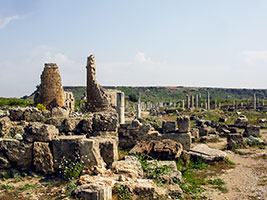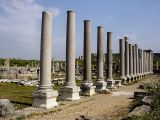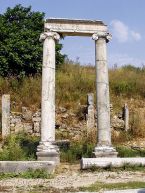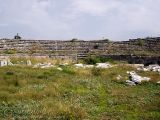The most impressive ruins of the Pamphylian coast are at the antique city of Perge or Perga, at about 15 km east of Antalya.
Historical Background
Perge was originally founded by the Hittites around 1500 BCE. and was known as Parha. It was a successful trading centre near the Aksu (ancient Kestros or Cestrus) river when Alexander the Great arrived in 333 BCE. He was welcomed in by the inhabitants and used Perga as a base for his Anatolian campaigns. Alexander was followed by the Seleucids under whom the city prospered and Perge's most celebrated inhabitant, the mathematician Apollonius of Perga lived and worked here. Apollonius was a pupil of Archimedes and wrote a series of eight books on geometry.
In 188 BCE, Perge became part of the Roman Empire. During this time the city flourished and most of the surviving buildings date from this period. St. Paul started his journey in Perge (Biblical Perga) in 46 CE and preached his first sermon here. Perge gradually declined during the Byzantine period, as the Aksu river silted, but remained inhabited until Selçuk times after which it became abandoned.
Sights & Photos of Perge
A visit to Perge starts by entering the archaeological site through the Roman Gate, built during the reign of Septimius Severus (193-211 CE). Proceeding through the gate, to the right is the Agora or marketplace. This structure of 75 x 75 m dates back from the 2nd century CE. The centre courtyard and shops were surrounded by a wide stoa, a covered walkway. The floor of the stoa and shops was made of coloured mosaics. The agora was not only the centre of Perge's trade, but was also a place for meetings as well as a forum for political, social, and philosophical discussions.
https://www.turkeyphotoguide.com/perge?tmpl=component&print=1#sigProId0557c44afe
The next building is the Hellenistic city gate that dates back to the 3rd century BCE. This is certainly the most imposing building of Perge and was cleverly designed to protect the city with its twin towers and its horseshoe-shaped courtyard at the back. It is thought that the towers had three floors and were crowned by a conical roof. In the year 121 CE, the horseshoe-shaped courtyard was redesigned as a courtyard of honour. Behind the courtyard stood a triple arch. Around the arch, there are about a dozen inscriptions connected with Plancia Magna who lived in the 2nd century AD. She was the daughter of the governor, a priestess of Artemis Pergaia (Diana) and a benefactress to the city. Plancia Magna had the arch decorated with the statues of the emperors and their relatives.
https://www.turkeyphotoguide.com/perge?tmpl=component&print=1#sigProId855df661b2
After passing through the Hellenistic Gate and courtyard, one enters a broad, marble-paved double-collonaded street measuring 300 meters in length, extending from the main gate to the acropolis of Perge. The street is 20 m wide and is divided in two by a 2-meter wide water channel running down the middle. At the end of the collonaded street is the Nymphaeum, a triumphal fountain from where a stream flowed down into the water channel. The nymphaeum is an ornamental semicircular structure and dates from the reign of Emperor Hadrian (130-150 CE). A statue of a river god Kestros was located in the centre of this huge fountain. Behind the nymphaeum lies the acropolis with some remains of the Byzantine period. To the west of the nymphaeum are the remains of a Roman palaestra dating from 50 CE, built by Gaius Julius Cornutus Bryonianus and dedicated to Emperor Claudius (41-54 CE).
https://www.turkeyphotoguide.com/perge?tmpl=component&print=1#sigProId81b4123205
Returning back to the entrance, there are the excavated Roman baths located southwest to the agora. Like Turkish hammams, Roman bathhouses consisted of a complex of rooms, such as the hot room and the cold room. The latter, called frigidarium in Latin, was also discovered here at Perge.
Out of the site proper, is the horseshoe-shaped stadium, the largest in Asia Minor, measuring 234 m by 34 m. The stadium had a seating capacity of 12,000 people supported by massive barrel-vaulted constructions. Just beyond the site entrance is also Perge's theatre, which is of the Greco-Roman type and could seat 15,000 people. Unfortunately, it has been for some time under reconstruction and is unfortunately closed to visitors.
https://www.turkeyphotoguide.com/perge?tmpl=component&print=1#sigProIdd3a02b1fa3
Travel Information & Travel Tips
A trip to Perge is usually combined with a visit to the nearby Roman theatre at Aspendos as a half-day tour from Antalya.
































